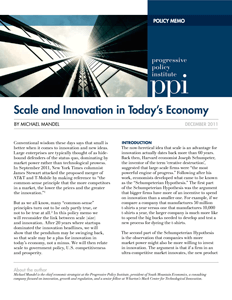Scale and Innovation in Today’s Economy
By: / 12.07.2011
 Conventional wisdom these days says that small is better when it comes to innovation and putting new ideas into practice. Large enterprises are typically thought of as hidebound defenders of the status quo, dominating by market power and brute force rather than technological and innovative prowess.
Conventional wisdom these days says that small is better when it comes to innovation and putting new ideas into practice. Large enterprises are typically thought of as hidebound defenders of the status quo, dominating by market power and brute force rather than technological and innovative prowess.
Yet reality is far more complicated than this simple small versus big distinction. As we all know many common-sense beliefs turn out to be only partly true, or not to be true at all.
In this policy memo we will reconsider the link between scale (size) and innovation. After 20 years where startups have rightly dominated the innovation headlines, we will show that the pendulum may be swinging back. As a result, there are reasons to believe that scale may be a plus for innovation in today’s economy, not a minus. We will then relate scale to government policy, U.S. competitiveness and prosperity.
In this policy memo we will reconsider the link between scale (size) and innovation. After 20 years where startups have rightly dominated the innovation headlines, we will show that the pendulum may be swinging back. As a result, there are reasons to believe that scale may be a plus for innovation in today’s economy, not a minus. We will then relate scale to government policy, U.S. competitiveness and prosperity.
The now-heretical idea that scale is an advantage for innovation actually dates back more than 60 years. Back then, Harvard economist Joseph Schumpeter, the inventor of the term ‘creative destruction’, suggested that large-scale firms were “the most powerful engine of progress.” Following after his work, economists developed what came to be known as the “Schumpeterian Hypothesis.” The first part of the Schumpeterian Hypothesis was the argument that bigger firms have more of an incentive to spend on innovation than a smaller one. For example, if we compare a company that manufactures 50 million t-shirts a year versus one that manufactures 10,000 t-shirts a year, the larger company is much more like to spend the big bucks needed to develop and test a new process for dyeing the t-shirts.
The second part of the Schumpeterian Hypothesis is the observation that companies with more market power might also be more willing to invest in innovation. The argument is that if a firm in an ultra-competitive market innovates, the new product or service is quickly copied by rivals, so that the gains from innovations are quickly competed away. Conversely, a firm with market power has the ability to hold onto some of its gains from innovation, so it may pay to invest in product or other improvements.
Together, these two conjectures are among the most controversial and most widely studied of economic theories. Economists and business experts have generated a long series of theoretical papers, econometric analyses, case studies, and anecdotal reports, examining the impact of scale on innovation.
After all this research, we can summarize the economic evidence for and against the Schumpeterian hypothesis in two words: It depends. Part of the problem is that innovation influences scale, as well as vice versa. A successful and innovative small or medium-size company will often grow to be a successful and innovative large company, which perhaps dominates its market because of its very success.
At the same time, the link between scale and innovation, positive or negative, depends on the economic environment. In this policy memo, we will suggest that the current U.S. economy is dealing with a particular set of conditions that will make scale a positive influence on innovation. First, economic and job growth today are increasingly driven by large-scale innovation ecosystems, such as the ones surrounding the iPhone, Android, and the introduction of 4G mobile networks. These ecosystems require management by a core company or companies with the resources and scale to provide leadership and technological direction. This task typically cannot be handled by a small company or startup.
Second, globalization puts more of a premium on size than ever before. A company that looks large in the context of the domestic economy may be relatively small in the context of the global economy. In order to capture the fruits of innovation, U.S. companies have to have the resources to stand against foreign competition, much of which may be state supported.
Finally, the U.S. faces a set of enormous challenges in reforming large-scale integrated systems such as health, energy, and education. Conventional venture-backed startups don’t have the resources to tackle these mammoth problems. Only large firms have the staying power and the scale to potentially implement systemic innovations in these industries.
We finish this policy brief with some observations about scale, innovation, and government policy. In particular, we raise questions about whether an aggressive policy of filing antitrust actions against America’s key technological leaders is really the optimal course for improving U.S. competitiveness, raising living standards, and boosting job growth in the U.S.

